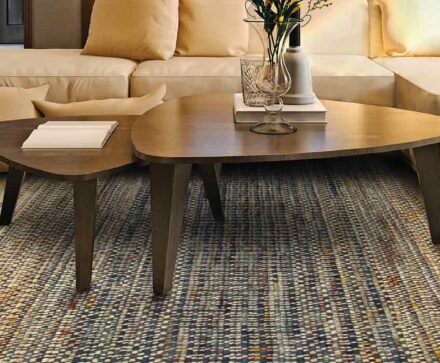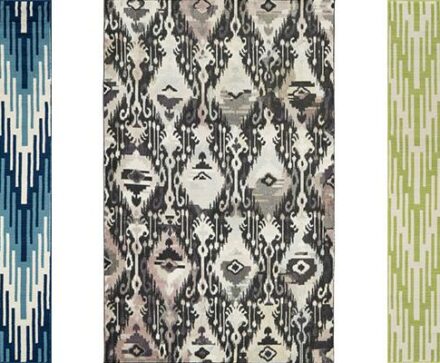Understanding Rug Materials
Transcript
What are the most common materials that rugs are made of?
The most common materials today that rugs are made out are usually, I’d say, three products. One is polypropylene which is synthetic fiber, the other one is viscose which is usually made from what people call bamboo silk, or whatever you want to call it, faux silk, which is usually made from pulp from natural materials like wood and things of that nature that could make paper, and the other one would be wool of course.
Is one material better than the other?
My personal choice out of all those three fibers is wool, but there are things that make one fiber better than the other in different cases. As far as I’m concerned, wool is the best wearing fiber, it looks better with wear, cleans better and looks more like the rug you bought originally than any other product you’re going to buy. It’s like buying a good wool suit, you know, it’s always going to keep that good look until you basically wear it out. Whereas synthetic fibers like polypropylene, it’s an inert material, it won’t absorb so it won’t stain, which is the great thing about it. The problem is that it tends to dull, it tends to get dingy looking, you never really wear it out and it just looks dirty or dingy in those traffic areas.
I always say the best way to do it is to think of it this way, if you took a piece of glass, basically that’s what’s happening with that polypropylene fiber, when you look under a microscope, it’s like a real smooth, clean, clear glass-looking product. Basically, you can imagine if you walk on something, it’s like taking a piece of sandpaper to glass. You start rubbing that glass with sandpaper, just like grit from your shoes, eventually it starts dulling that clear finish on the glass and becomes opaque and basically dulls it and you can’t really see…it’d be like a bathroom glass that we’d use in a shower or something like that where you don’t want somebody to see in.
And so that’s what happens with synthetic fibers. You don’t really wear them out, they are great for stain resistance, which they will beat wool in that performance. They just don’t look as good long-term as far as wear. And then don’t get me started on viscose. I am not a believer in viscose, but if you want a rug that looks like silk, actually looks better than silk, viscose is it, it’s incredibly popular today. I think the big thing is the performance, it doesn’t — it’s really soft, it’s very absorbent, it stains very easy, it’s tough to clean. There’s a lot of — just keep going on and on of things that are not great about viscose. We saw a lot of it, it’s very popular, the big thing is just to let you know what to expect out of that fiber.
A lot of people just love the way it looks. I always say, “Gee wiz, I really like that, but can you show me something that looks just like it, that will not have those characteristics?” There is no such thing, unless you buy silk, and then silk could be twice as much as viscose would be, at least.
How well do the different types of materials wear over time?
I think the big thing about, if you look at value in the different types of products that are wools or different kinds of fibers that are used in rug making today, polypropylene is basically a by-product of oil, it’s the waste from making oil. There’s a lot of it out there, it’s very reasonable to buy and it’s very affordable, plus it looks great, they’ve done a lot with that yarn system and it really does look fantastic in rugs today. I have to say it’s very, very popular.
Viscose is usually made from bamboo which a lot of people think of bamboo and they think about silk. They think bamboo is hard as a rock and you can’t really hurt it, but viscose will not perform or stand through tough wearing or staining and things of that nature.
Wool is probably my personal favorite as far as performance and will give you that great look for a long period of time.
What about stainability and cleanability?
Polypropylene is an inert material which means that it can’t absorb. Basically, you can put anything on it, you can take outside and hose it down. If you look at what they’re using in stadiums, that’s a derivative of polypropylene, basically. So it’s a great, tough fiber that’s unstainable which is great about it. Like I said, the big thing about polypropylene is it won’t keep that crisp new look long-term with wear. The traffic lanes tend to dull out, it’s a little more crushable if you don’t weave it tight enough. Those are some of the downfalls, but as far as stainability, the best, no doubt about it.
Viscose is the least thing you want to buy as far as stain resistance. It is guaranteed to absorb stains and tough to get out. One thing nice about viscose is that it looks so beautiful, you just want it. The big problem is that it’s made like you would make paper. Imagine grinding pulp up, and you make paper; now if you want to take a paper towel and absorb something it just sucks up all that moisture. The same thing with stains, it will just suck every stain right through it, that’s very hard to get out, in fact almost impossible in some cases.
Then the other would be wool. One thing, wool is very resilient as far as staining. It usually takes a little bit of time for it to accept the stain but eventually it will. Wool can absorb about 30% of its weight in moisture. There is a possibility that you can get a stain in wool and it is not easy to clean out. It’s 100 times better than when using viscose to get a stain out. Whereas when you’re doing a polypropylene that’s pretty much unstainable.


